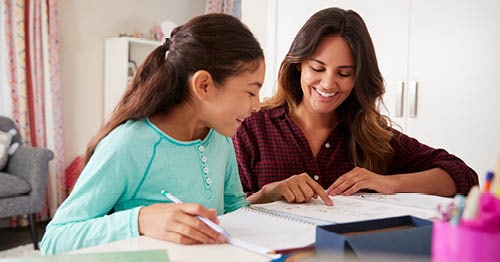Maintaining a Summer Routine for Middle Schoolers
by Cassandra Polzin
byNell Gladson
6 min to readStudents with a learning disorder can find it difficult to keep up with their peers in the classroom. Some parents make the choice to enroll their child in online school as a way of providing them added flexibility and support with their individual needs. If dyslexia has been identified in your student—or you suspect it could be the cause of learning struggles—there are ways to help them adapt and succeed in online school.
Dyslexia is a learning disorder that primarily impairs a person’s ability to read, write, and spell. Exact numbers are hard to pin down, but it’s estimated that as many as one in five people have dyslexia. It’s the most common language-based neuro-cognitive condition—found in 80-90% of individuals who have a learning disorder.
Dyslexia affects each person uniquely depending on its severity and which symptoms they experience. According to the International Dyslexia Association (IDA), the common effects of dyslexia include:
People with dyslexia may also experience struggles with spoken language that can make it hard for them to clearly communicate and fully understand the speech of others. It can also impact functioning in social situations, self-esteem, and memory.
The signs of dyslexia show themselves both in and out of the classroom. The Child Mind Institute developed a list of signs that includes:
Researchers use two categories to differentiate types of dyslexia based on potential causes.
The first category is developmental. Developmental dyslexia is present from birth and is separated into two sub-categories: primary and secondary.
The second category of dyslexia is acquired. Secondary dyslexia results from a traumatic brain injuries, serious illnesses, or strokes. It can develop at any time in a person's life.
Dyslexia is typically diagnosed by a licensed educational psychologist, neurologist or any other medical professional that may be qualified to provide a formal diagnosis.

Helping students with dyslexia succeed in online school takes time, patience, and good old-fashioned persistence. If dyslexia hasn’t been identified yet, the first step is to talk to teachers about the issues you see. It’s also a good idea to talk to the child’s health care provider to rule out medical causes like vision or hearing impairments.
While dyslexia is typically identified under one of the 13 IDEA special educational eligibility categories, called Specific Learning Disability (SLD), some states have specific guidance on dyslexia screenings and intervention. Regardless, any student with this medical diagnosis can be supported through direct research-based instruction and intervention.
There are many ways to support educational growth in students with dyslexia—both in class and at home. Below are five strategies Learning Coaches can use to help a child manage the condition.
It’s common for students with any learning disability to receive accommodations at school, such as through accommodations that become part of a student’s individualized education plan.
The IDC separates dyslexia accommodations into four basic types: presentation, response, setting, and timing/scheduling. They are useful in all learning settings, but online students tend to have more flexibility in adopting them. Examples include:
Since research educators understand how students learn to process language, children with dyslexia can learn to read effectively with the proper instruction. Here are some teaching methods that experts recommend:
Making the effort to help a child with dyslexia at home can make a big difference. Learning Coaches will never replace a student’s teacher, but they can help online students grow outside of class. Here are some things you can do:
Little things can mean a lot when it comes to nurturing self-confidence and supporting a student with dyslexia’s wellbeing. Ways to be emotionally supportive include:
From reading tutors to certified academic language therapists, adding in professional expertise in developing individual learning plans for students with dyslexia is an option that works for some.
The most important thing to do for a student with dyslexia is to act now. Without proper instruction, dyslexia can continue to have a negative effect into adulthood.
by Cassandra Polzin
by Valerie Kirk
by Elizabeth Preston
